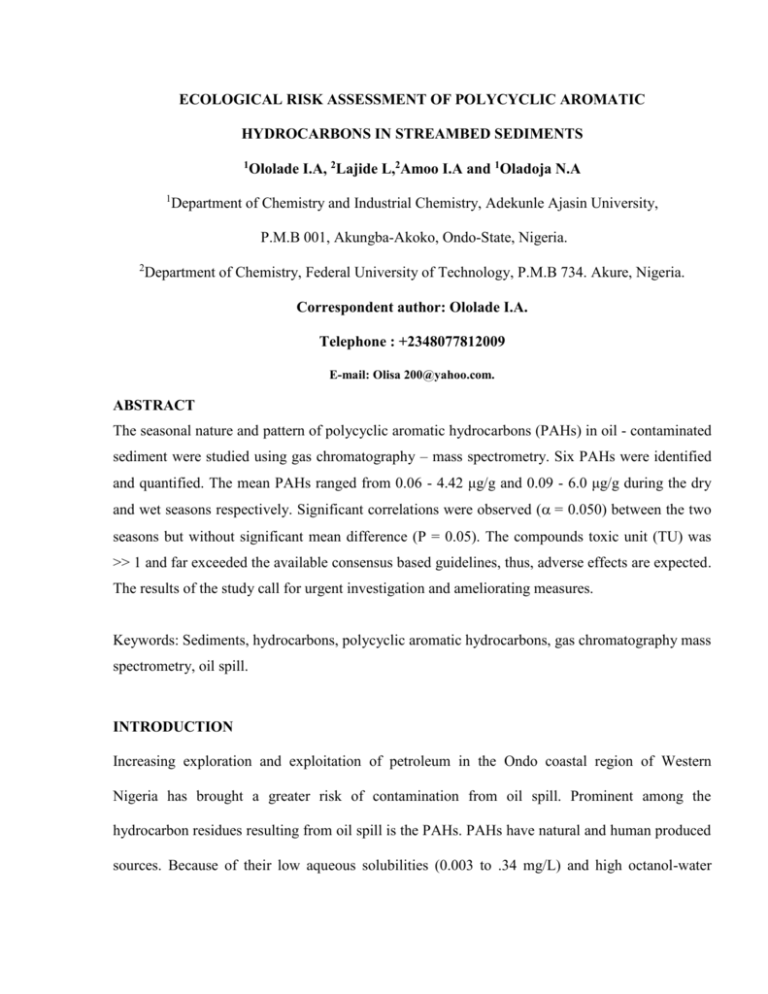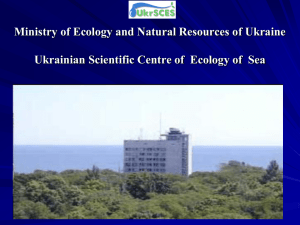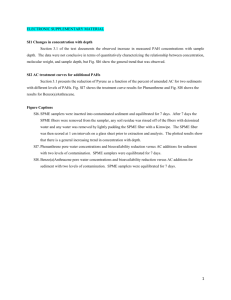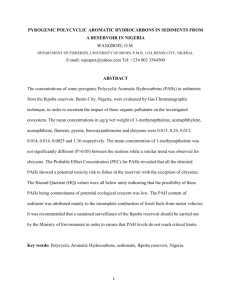ecological risk assessment of polycyclic aromatic
advertisement

ECOLOGICAL RISK ASSESSMENT OF POLYCYCLIC AROMATIC HYDROCARBONS IN STREAMBED SEDIMENTS 1Ololade 1 I.A, 2Lajide L,2Amoo I.A and 1Oladoja N.A Department of Chemistry and Industrial Chemistry, Adekunle Ajasin University, P.M.B 001, Akungba-Akoko, Ondo-State, Nigeria. 2 Department of Chemistry, Federal University of Technology, P.M.B 734. Akure, Nigeria. Correspondent author: Ololade I.A. Telephone : +2348077812009 E-mail: Olisa 200@yahoo.com. ABSTRACT The seasonal nature and pattern of polycyclic aromatic hydrocarbons (PAHs) in oil - contaminated sediment were studied using gas chromatography – mass spectrometry. Six PAHs were identified and quantified. The mean PAHs ranged from 0.06 - 4.42 μg/g and 0.09 - 6.0 μg/g during the dry and wet seasons respectively. Significant correlations were observed (= 0.050) between the two seasons but without significant mean difference (P = 0.05). The compounds toxic unit (TU) was >> 1 and far exceeded the available consensus based guidelines, thus, adverse effects are expected. The results of the study call for urgent investigation and ameliorating measures. Keywords: Sediments, hydrocarbons, polycyclic aromatic hydrocarbons, gas chromatography mass spectrometry, oil spill. INTRODUCTION Increasing exploration and exploitation of petroleum in the Ondo coastal region of Western Nigeria has brought a greater risk of contamination from oil spill. Prominent among the hydrocarbon residues resulting from oil spill is the PAHs. PAHs have natural and human produced sources. Because of their low aqueous solubilities (0.003 to .34 mg/L) and high octanol-water partition coefficient (log Kow = 3.4 – 7.6), PAH compounds in aquatic system tend to be associated with sediment and biota [1]. The aromatic hydrocarbons are generally more toxic than aliphatics, with the toxicity of aromatics increasing with the numbers of rings and with degree of alkyl substitution. However, solubility decreases with increasing number of rings and alkyl groups. Thus, the most toxic petroleum hydrocarbon may be compound of 4 - 5 rings aromatics, although the most toxic contribution may be exerted by mono or dinuclear aromatics. Research shows PAHs have negative effect on humans, mammals’ invertebrates, birds and fish. As of 2001, about 17 PAHs have been registered as priority pollutants and with sufficient evidence to be considered toxic, carcinogenic and mutagenic [2,3]. Studies have shown that each source of PAHs has a characteristics pattern and the usefulness of PAH isomer ratios, such as phenanthrene/Anthracene (tricyclic aromatic, MW178) were demonstrated for source identification [4]. Lower molecular weight PAHs e.g phenanthrene and anthracene are known to be acutely toxic to aquatic organisms and are more easily degraded unlike the higher molecular weight compound which will tend to predominate in sediment where they are subjected to burial, resuspension, and degradation reactions [5]. The biodegradation of PAH probably occurs more slowly in aquatic system than in soil [6]. Seasonal and historical changes on disposition of PAHs have been determined using sediment core in several studies [4,7]. In fact, aquatic ecosystem remains one of the major sinks of PAH contamination,which has received most attention because of their lipophilic characteristics and bioconcentration effect [8]. Additionally, consequently upon the environmental significance of PAHs, extensive studies in sediment, bottom sediments of Lorence Greek lake and urban run off have been carried out [9]. The increasing ubiquitous presence of these compounds, especially as those derived from petroleum in ocean, lakes and rivers in the form of spills necessitates the development of practical means of determining such pollutants in the natural environment. Sediment exposure to PAHs has been characterized by comparing sediment PAH concentration exposure with sediment quality benchmarks empirically derived from 28-day toxicity tests using Hyalella azteca (HH-28 ).The database was constructed using data from several contaminated sites [10,11,12]. These benchmarks represent the concentration below which toxicity is frequently observed (Effects Range Median., ERM). Little environmental data is available for the coastal region of Ondo state located within the South-Western region of Nigeria [13]. The Ondo coastal region is known for biological production and is especially important for commercial fish. Several oil wells are located around the study area in recent years have resulted in increase spills. In an attempt to create an enabling environment for recreational activities within the area, this study thus become very necessary. It is equally hoped that hydrocarbon source could be identified which will help to establish the distribution pattern. Consequently, the most effective, hyphenated gas chromatography –mass spectrometry (GC-MS) is employ for the study based on literature guidance. MATERIALS AND METHOD Study Area Figure 1 show the study areas from which sample of sediment were randomly Collected.Ondo State is one of the oil producing state, located in the south western part of Nigeria. The climate is tropical with two distinct seasons: the rainy season (April – October) and dry season (November – March). The sampling sites are locations that are previously noted for large biological production and especially important for commercial fish. However, the unfortunate began in 1996 when the first oil spill occurred [14]. Large area of mangroves ecosystem have been destroyed within the area as a result of toxicity from persistent oil spillage. Consequent upon the negative impacts of this unpalatable experience, this study was carried out. The database derived is hoped to serve as a guide to possible ameliorating programme. Sampling Basically, two sites (consisting of five locations each) were selected within the ecological zone. Some of the variables that influenced site selected included proximity to oil wells locations and high level of socio-economic activities, particularly fishing within the area. Samples were collected at both the two common seasons in Nigeria (Wet and Dry). The exact positions of the sampling points were noted using the global positioning system (GPS) and the details are presented in Table 1.The samples were collected at each site, one from midstream and one from each bank in a cross section fashion and later homogenized into a composite sample from which representative samples were taken based on APHA standard method [15]. Samples were collected and rapped inside aluminium foil after proper labeling. The samples were subsequently placed inside coolers containing ice-bag and transferred into the laboratory where they were preserved in the freezer prior to analysis. 2.3. Saponification and extraction About 100g of partially thawed sediment sample was weighed and transferred into a pre-cleaned extraction thimble which was then placed in the inner tube of the soxhlet apparatus containing 140ml DCM to which boiling chips had been added. Internal standard (anthracene, phenanthrene and pyrene) were used. The sediment sample was extracted for 8 hours and cooled. 20ml of 0.7M KOH and 30ml of pre-extracted water (with hexane) was added to the sediment solvent flask. The non-saponifiable lipids (containing the petroleum hydrocarbons) was carefully reduced to about 15ml and then partitioned with hexane in 100ml glass separatory funnel. 40ml hexane was used and the mixture washed with 25ml 0.1M Na2CO3 (in triplicate).The separated organic layer was filtered through glass wool and anhydrous sodium sulphate to dry the extract. The volume was reduced on a water bath maintained at 300C. The final evaporation of the extract was carried out under nitrogen gas and the dried extract was chromatographed The extracts were eluted through a silica-alumina glass column for the removal of polar lipids and other biogenic interferences, and the samples were concentrated to a volume of 5ml. The fractions were combined and dissolved in a known amount of dichloromethane prior to GC-MS measurement. Gas chromatography – mass spectrometric (GC –MS) analyses The capillary gas chromatography – mass spectrometry analysis were performed on a Hewlett – Packed (HP) 6890 GC series instrument coupled with a 5975 Hewlett – Packed mass spectrometer (MS). The capillary column used was of the Agilent 1909IS – 433 model with dimensions of 30m x 0.25mm ID x 0.25μm film thickness of HP- 5M5 (5% Phenyl Methyl Siloxane). Full scan mass spectra between 35 and 500m/z were acquired once every second. The peaks in the chromatogram were identified by comparison of the retention times and mass spectra data of reference compounds with those in the sample using MS Library Wiley and NIST. The peaks were quantified using the flame ionization detector (FID) through a five point calibration curve. RESULTS AND DISCUSSION Two of the chromatograms obtained during the dry and wet seasons are presented in Figs 2 and 3 respectively. The mass spectrophotometric details of the total ion current trace for some of the PAHs are equally presented in Fig.4 (a-f). All together, about six different PAHs (anthracene, Azuleno[2,1-b]thiophene, benz[a]anthracene, carbazole, dibenzothiophene and phenanthrene) were identified in the sediments extracts from the two studied site. Total PAHs concentrations were summed from individual compounds identified. The highest total PAH concentrations (Table 1) ranging from 0.11 to 6.00μg/g was detected at site B during the wet season, while the least, ranging from 0.06 to 3.02μg/g was detected at site A during the dry season. Phenanthrene and anthracene were the PAH compounds most frequently detected at the highest concentration. The data in Table 1 equally showed that concentrations are equally higher for almost all the PAHs at site B. This may be explained to be due to the closeness of the site to the Atlantic Ocean, through which anthropogenic oil spill enters the hinterland. The trend in the concentration at both seasons are almost similar with the PAH concentrating more during the wet season. Significant positive correlation (α = 0.01) were observed between PAHs concentration during both seasons ( r = 0.998 and 0.923 ) at site A and B respectively but without any significant mean difference (P = 0.077 and 0.118 respectively). Though, dry season samples were first collected, it was thought that concentration during the wet season would be less due to the prevailing ecological conditions at the times. However, the increased levels during this period further implicate the continuous release of hydrocarbon residues into the area. It also re-affirms that sediments are capable of adsorbing organic pollutants such as PAHs. Using the sediment quality benchmarks empirically derived from 28 – days toxicity tests rising HA – 28 [11,12,16], all the sediment samples taken at both seasons have their PAH concentrations exceeding the ERM for anthracene, Benz[a]anthracene and phenanthrene. Thus, exposure of sediment – dwelling organism to PAHs is likely at these sampling locations. In fact, anthracene and phenanthrene exceeds the consensus – based probable effect concentration (PEC) as indicated in Table 2. However, concentration of Benz[a]anthracene was found to be < PEC but > TEC. All these are indicative of serious health hazards for the ecosystem. For each PAH identified in Ondo coastal sediment, a toxic unit (TU) was calculated by dividing the sediment PAH concentration by the HA – 28 ERM based on reported model [11,12,17]. The TUs for each PAH identified are included Table 1 in parenthesis. However, guidelines for some of the identified compounds are unavailable; thus, their TUs could not be calculated. The summation of these TUs is indicative of the overall estimated PAH toxicity of the sample. As indicated in Table 1, the ΣTU>> 1,thus, adverse effects are expected based on literature guidance [11,12]. Phenanthrene (Phe) is generally more stable thermodynamically than anthracene (Ant),and the ratio Phe/Ant, is a reflection of the origin of PAHs; petrogenic or pyrogenic in the environment [4]. A high ratio of Phe/Ant ( > 15) is characteristic of petrogenic source, while pyrogenic is characterized by lower ratio. In the present report, the ratio Phe/Ant was 1.28 0.16 (average SD, n = 8) in the sediment. Thus, the PAHs are more from a pyrogenic than petrogenic source. Polycyclic aromatic hydrocarbons (PAHs), because of their hydrophobic character show strong adsorption affinity to solid particles in aqueous matrices [18]. The data further implicates that the oil residues consist mainly of heavier portion which tend to sink and become sedimented. Thus, extent of hydrocarbon adsorption was found to be positively correlated (r = 0.8335) with the organic carbon (OC) present in the sediment at both dry and wet seasons (Fig 5). The impact of the PAHs in Ondo costal environment on populations of benthic organisms may be very devastating based on the fact that the concentration of PAHs measured in the sediments are comparable to other contaminated sites in which severe impacts have been observed [4,15,19]].Thus, sediment – dwelling or burrowing organisms are at the greatest risk especially during the wet season because PAHs tend to remain bound to organic sediment. Aquatic organisms that reside on the sediment surface, restricted to the water column only, are likely to receive less expensive to the sediment – bound PAH, and are therefore at less risk. Though, not examined in this study, one possible impact of PAHs identified is the induction of tumors, particularly in fish. Several workers have shown that most PAH such as carbazole, phenanthrene, have shown to be mutagenic and carcinogenic in laboratory studies [15,20,21,22,23,24,25]. It is hoped that some site-specific resident organism and important marine species will be investigated to further establish the present findings. CONCLUSION Oil spills has occurred several times along the Ondo coast in Nigeria, which is at the Gulf of Guinea as a result of upsurge in oil exploration and exploitation activities. Through this study, sediments further demonstrate its adsorbing capacity of toxic pollutants such as PAHs. It was also observed that these chemical pollutants are capable of building up (bioaccumulate) within the system, this poses serous threat to sediment dwelling organism, other aquatic biota and eventually man through the food chain system. The study showed that the PAHs are more from a pyrogenic than petrogenic source. The temporal increase during the raining season is indicative of slow degradation and efficient adsorption into the sediment matrices. It is recommended that studies on site specific resident organisms should be investigated for their PAHs status. This will assist appropriate food regulatory agencies in policy formulation on seafood products. REFERENCES [1] NOAA (National Oceanic and Atmospheric Administration).,1998, EVS project No9: 2/575 – 37; 2/789 – 10. USEPA, Chicago, pp 22. [2] US EPA.,1993, EPA/600/R-93/089. US Environmental Protection Agency, Office of Research and Development, Washington, DC. [3] Zahodiakin, P, 2002, EPA issues report on PAH Risk Assessment Meeting (TSCA), Pesticide and Toxic chemical News, Volume 31, p 12. [4] Ikenaka Y., Heesoo. E., Eiki W., Fuyio K and Yinchi M.,2005, Estimation of sources and inflow of Dioxins and Polycyclic Aromatic Hydrocarbons from the sediment core of Lake Suwa, Japan. Environmental Pollution, 138(3), 529 – 537. [5] Villeneuve,D.L.,Khim, J.S.,Kannan, K.,Giesy,J.P, 2002, Relative potencies of individual PAHs to induce dioxinlike and estrogenic responses in three cell lines. Environmental Toxicology, 17, 128-137. [6] Clement, C, 1985, Chemical, physical and biological properties of compounds present of hazardous waste sites. Proposed for the U.S. Environmental protection Agency, Washington DC. Clement Associates. [7] Takeda, Y., Kassa, K., Limura, F., Tukui, T., Yoshioka, H., Higashino, K., Saswaki, Y.,2003, Journal of Environmental Chemistry, 13, 397 – 407 In: Ikenaka Y., Heesoo. E., Eiki W., Fuyio K and Yinchi M.,2005, Estimation of sources and inflow of Dioxins and Polycyclic Aromatic Hydrocarbons from the sediment core of Lake Suwa, Japan. Environmental Pollution, 138(3), 529 – 537. [8] Guzzella, L. and Depaolis,A., 1994. Polycyclic aromatic hydrocarbons in sediments of the Adriatic Sea. Marine Pollution Bullettin 28,159. [9] Ging. P. B., vanMetre, P. C. and Callender E (2001). ‘Bottom Sediments of Lorence Creek Lake, San Antonio. Texas, reflect contaminants trends in an Urbanizing watershed’. http://waterusgs.gov/ [10] Ingersoll, C.G., Haverland, P.S., Brunson, E.L., Canfidd, T.J, Dryer, F.J., Henke, C.E, Kemble, N.E, Mount, D.R and Fox, R.H., 1996. Calculation and evaluation of sediment effects concentrations for the amphipod Hyalella azteeca and the midge Chironomus riparius. Journal of Great lakes Resources. 22, 602 – 623. [11]MacDonald, D.D., Dipinto, L.M, Field, J, Ingersoll C.G.: long E.R and Swarts R.C. (2000)a. Environ. Toxicol.Chem. 119, 1403 – 1413. [12]MacDonald, D.D., Ingersoll C.G. and Berger T.A.(2000)b Arc.Environ. Contam.Toxicol. 39, 20– 31. [13]Asaolu, S.S (1998). Chemical pollution studies of coastal waters of Ondo State,Nigeria. Ph.D Thesis, Federal University of Technology, Akure, Nigeria. [14]Ondo State Environmental Protection Agency (ODSEPA). (2000).Report from the alleged crude oil spill on Ilaje communities, Ondo State, from Chevron Nig. Ltd Ewan Production Platform. Final Report., July. [15]Aderemi O.O., Olabode I.A and Olalekan S.F.(2003). Isolation an ddetermination of polycyclic aromatic hydrocarbons in surface runoff and sediment. Water, Air and soil pollution 147: 245-261. [16]USEPA,(1996). Assessment and Remediation of Contaminated Sediments (ARCS) program. Calculation and evaluation of sediments effect concentrations for the amphipod Hyallela azteca and chironomus riparius. EPA 905/R – 96/008. Great lakes National program office, Chicago, Illinois. [17]Long E.R and Morgan L.G, (1991). NOAA Technical memorandum WOSOMA 52. National Oceanic and Atmospheric Administration. Seattle, Washington, in 175 + appendices,USEPA (United State Environmental; Protection Agency). (1996). EPA 905/R-96/008. Great lakes National program office Chicago, Illinois. [18] Lombas-Garcia, E., Gans, O., Krska R., Grasserbauer M., 1998, Supercritical fluid extraction versus ultrasonic extraction for the analysis of polycyclic aromatic hydrocarbons from reference sediments. Internaional Journal of Environmental Analytical Chemistry 72, 289. [19]Pavlora, A and Ivanora, R., 2003, Determination of petroleum hydrocarbons and PAHs in sludge from wastewater treatment basins. Journal of Environmental Monitoring 5, 319-323. [20]Myers, M.S., Rhodes, L.D., McCain, B.B., 1987., Pathologic anatomy and patterns of occurrence of hepatic neoplasms, putative preneoplastic lesions and other idiopathic hepatic conditions in English Sole (Parophrys vetulus) from Puget Sound, Washington. Journal of Natural Cancer Inst. 78, 333 – 363 [21]Dorene, E.M, Robert, W.B (1998). Organic compounds and trace elements in freshwater streambed sediments and fish from the Puget sound basin. National water-Quanty Assessment Programme USGS fact sheet. pp105 – 198. [22] Robertson, A. (1998). Petroleum hydrocarbons. In: AMAP Assessment Report. Arctic pollution issues, Arctic Monitoring and Assessment Programme (AMAP). pp 661 – 716, Osto, Norway [23]Ericson, G., Liewenborg, B.,Lindesjoo, E., Naf, C and Balk, L.,1999, DNA adducts in perch (perca fluviatilis) from a contaminated site in the River Angermanaliven, Sweden. Aquatic Toxicology. 45, 181-193. [24]Qanh, N. T. K., Reutergardh. L. B. and Dung, N. T., 1999, Emission of polycyclic aromatic hydrocarbons and particulate matter from domestic combustion of selected fuel.: Environmental Science Technology 33, 2703-2709. [25]Ghauch, A., Rima, J., Fachinger, C., Suptil, J., and Martin-Bouyer, M., 2000, ‘Room temperature phosphorescence analyses of PAHs using an imaging sensing system combined with a bifurcated optical fiber and a cooled charge coupled device detector’, Talanta 51, 807816. Table 1: Mea of PAH in (μgg-1)* in Sediments from Ondo Coast, Nigeria SITE A Anthracene Dry 2.08a±0.47 (12.24) 2.40a±1.12 Azuleno[2,1b]thiophene Benz[a]anthracene 0.14ab±0.12 (0.50) Carbazole 0.06b±0.02 Dibenzothiophene 0.18b±0.04 Phenanthrene 3.02c±0.12 (3.39) Σ PAH ( Σ TU) 7.88(20.13) Consensus- Consensusbased based TEC PEC SITE B Wet 2.30a±1.20 (13.53) 2.49a±1.10 Dry 4.01b±1.92 (23.59) 2.32a±0.92 Wet 5.70b±2.07 (33.53) 2.64a±1.02 0.16ab±0.09 (0.57) 0.09ab±0.04 0.25c±0.13 3.44c±1.04 (8.39) 8.73(22.52) 0.11ac±0.05 (0.32) 0.07b±0.03 0.16b±0.09 4.42cd±2.04 (10.78) 11.09(34.69) 0.13b±0.07 (14.63) 0.11ac±0.05 0.20bc±0.04 6.00bcd±2.04 (14.63) 14.78(48.62) 0.057 0.845 NG NG 0.108 1.050 NG NG 0.204 NG NG 1.170 * Concentrations are means of triplicate analysis. Values in parenthesis are Toxic Units (TU) Means in the same row followed by the same superscript are not significantly different ( α = 0.05 ) according to Duncan’s New Multiple Range Test. ERM: For anthracene (0.17 μgg-1); phenanthrene (0.41μgg-1); Benz[a]anthracene (0.28μgg-1) TEC: Threshold effect concentration (MacDonald et al., 2000) PEC: Probable effect concentration (MacDonald et al., 2000) PEL – HA 28 : Probable effect level for Hyalella azteca: 28-day test, dry weight(USEPA,1996) NG: No guidelines for TEC and PEC. Fig. 1: Map of the study area (Inserted is the area map of Nigeria and Africa showing the geographical location) Fig. 2: A typical chromatograms of the sediment extract during the dry season. Fig. 3: A typical chromatograms of the sediment extract during the wet season. a b c d e f (Benz[a]anthracene) Fig. 4 (a – f): Mass spectrophotometric of total ion current trace for identified PAHs 18 16 y = 1.9419x - 4.293 ΣPAH(μgg-1) 14 2 R = 0.8335 12 10 8 6 4 2 0 0 2 4 6 8 10 12 %OC Fig.5: Σ PAH concentrations with sediment organic carbon content (p < 0.05)








